Timeline of the Jin dynasty (266–420) and the Sixteen Kingdoms (304–439)
This is a timeline of the Jin dynasty (265–420) and the Sixteen Kingdoms (304–439).
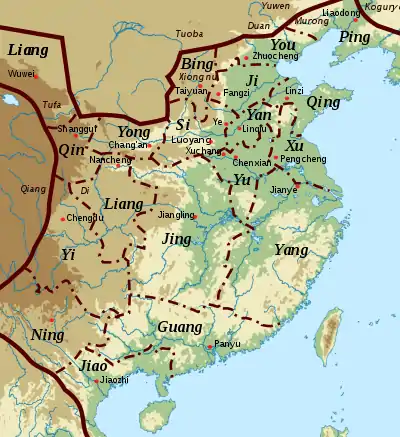
Western Jin dynasty in 280 AD
260s
| Year | Date | Event |
|---|---|---|
| 266 | Sima Yan (Emperor Wu of Jin) declares himself emperor of the Jin dynasty[1] |
280s
| Year | Date | Event |
|---|---|---|
| 280 | Conquest of Wu by Jin: Sun Hao surrenders to Jin; so ends the Three Kingdoms period[1] | |
| 284 | 30,000 Xiongnu submit and settle in Xihe (in Shanxi[1] | |
| 285 | Du Yu, commentator of the Zuozhuan, dies[1] | |
| 286 | 100,000 Xiongnu submit at Yongzhou[1] | |
| 289 | Murong Gui of Xianbei submits[1] |
290s
| Year | Date | Event |
|---|---|---|
| 290 | Emperor Wu of Jin dies and is succeeded by Sima Zhong (Emperor Hui of Jin) and Yang Jun assumes regency[1] | |
| Liu Yuan is appointed area commander-in-chief of the Five Regions of Xiongnu[1] | ||
| 291 | War of the Eight Princes: Empress Jia Nanfeng kills Yang Jun, Sima Liang, and Sima Wei[1] | |
| 295 | Tuoba Luguan divides the Xianbei into three areas[1] | |
| 296 | The Di and Qiang in Qinzhou (秦州 and Yongzhou (雍州), in Shaanxi and Gansu, rebel; Qi Wannian of Di declares himself an emperor[2] | |
| Chouchi: Yang Maosou sets up Chouchi south of Tianshui[3] | ||
| 297 | Tuoba Yiyi of Xianbei begins to conquer the Western Regions[2] | |
| 298 | Floods strike Jingzhou (荊州), Yuzhou (豫州), Xuzhou (徐州), Yangzhou (揚州), and Jizhou (冀州) (the middle and lower Changjiang and Huai valleys). Refugees from Lueyang (略陽) and Tianshui (天水) drift into Hanzhong (漢中) (south Shaanxi).[2] | |
| 299 | Qi Wannian is killed[4] |
300s
| Year | Date | Event |
|---|---|---|
| 300 | War of the Eight Princes: Sima Lun kills Jia Nanfeng, Sima Yun, Shi Chong, and Pan Yue[2] | |
| 301 | War of the Eight Princes: Sima Lun declares himself emperor and gets killed by Sima Jiong, Sima Ying, and Sima Yong[2] | |
| Li Te rebels in Guanghan (northeast Sichuan)[2] | ||
| 302 | War of the Eight Princes: Sima Ai kills Sima Jiong[2] | |
| 303 | Zhang Chang rebels in Jiangxia (江夏) (Yunmeng, Hubei) and sets up Qiu Chen as emperor[2] | |
| Lu Ji is killed[2] | ||
| 304 | War of the Eight Princes: Sima Yue imprisons Sima Ai, who is later killed[2] | |
| Emperor Hui of Jin relocated to Chang'an[2] | ||
| Former Zhao: Liu Yuan of Xiongnu declares himself Prince of Han (漢)[2] | ||
| Cheng Han: Li Xiong creates the Ba-Di state of Cheng Han[2] | ||
| 305 | Gongshi Fan, Ji Sang, and Shi Le rebel[5] | |
| Zuo Si dies[5] | ||
| 306 | Chen Min declares himself Duke of Chu in the lower Changjiang valley[5] | |
| Liu Baigen and Wang Mi rebel[5] | ||
| Sima Ying is killed[5] | ||
| Gongshi Fan is defeated[5] | ||
| Emperor Hui of Jin dies and is succeeded by Sima Chi (Emperor Huai of Jin), who moves back to Luoyang[5] | ||
| Cheng Han: Li Xiong declares himself emperor[5] | ||
| 307 | Ji Sang and Shi Le sack Ye, killing more than 10,000 people[5] | |
| Sima Rui is in charge of military affairs in the south[5] | ||
| Former Zhao: Shi Le joins Liu Yuan[5] | ||
| Murong Gui declares himself Great Chanyu[5] | ||
| 308 | Former Zhao: Liu Yuan takes Pingyang and declares himself emperor[5] |
310s
| Year | Date | Event |
|---|---|---|
| 310 | Former Zhao: Liu Yao, Shi Le and Wang Mi invade Luoyang, Xuzhou, Yuzhou, and Yanzhou[5] | |
| Former Zhao: Liu Yuan dies and his successor Liu He is killed by Liu Cong, who takes over[5] | ||
| Fu Hong declares himself Duke of Lueyang[5] | ||
| 311 | Former Zhao: Sima Yue dies and his funeral procession is ambushed by Shi Le, who annihilates the Jin army[5] | |
| Disaster of Yongjia: Liu Yao and Wang Mi sack Luoyang and capture Emperor Huai of Jin[5] | ||
| Former Zhao: Liu Yao takes Chang'an[5] | ||
| Former Zhao: Wang Mi is killed by Shi Le[5] | ||
| 312 | Former Zhao: Jin retakes Chang'an after routing Liu Yao[5] | |
| Former Zhao: Shi Le captures Xiangguo (襄國) (Xingtai, Hebei)[5] | ||
| Former Zhao: Liu Cong briefly takes Jinyang (southwest of Taiyuan, Shanxi) but is routed by Liu Kun[6] | ||
| 313 | Emperor Huai of Jin is killed by Liu Cong and is succeeded by Sima Ye (Emperor Min of Jin)[6] | |
| Goguryeo takes Lelang Commandery[7] | ||
| Tuoba Yilu names Shengle the northern capital and Pingcheng the southern capital[6] | ||
| 314 | Former Liang: Zhang Gui dies and is succeeded by Zhang Shi[6] | |
| 315 | Dai: Tuoba Yilu becomes Prince of Dai[6] | |
| 316 | Former Zhao: Emperor Min of Jin surrenders Chang'an to Liu Yao[6] | |
| 317 | Sima Rui declares himself Prince of Jin at Jiankang[6] | |
| 318 | Emperor Min of Jin is killed by Liu Cong and is succeeded by Sima Rui (Emperor Yuan of Jin)[6] | |
| Former Zhao: Liu Cong dies and his successor Liu Can is killed by Xiongnu general Jin Zhun, and is succeeded by Liu Yao[6] | ||
| 319 | Former Zhao: Jin Zhun is killed[6] | |
| Former Zhao: Liu Yao moves to Chang'an and renames his state Zhao[6] | ||
| Former Zhao: Fu Hong joins Former Zhao[6] | ||
| Later Zhao: Shi Le defeats Jin general Zu Ti at Xunyi and declares himself Prince of [Later] Zhao[6] |
320s
| Year | Date | Event |
|---|---|---|
| 320 | Former Zhao: Juqu Zhi rebels and is defeated[6] | |
| 321 | Later Zhao: Shi Le takes control of Youzhou, Jizhou, and Bingzhou[8] | |
| 322 | Wang Dun rebels in Wuchang[8] | |
| Later Zhao: Shi Hu invades Xuzhou and Yanzhou[8] | ||
| Emperor Yuan of Jin dies and is succeeded by Sima Shao (Emperor Ming of Jin)[8] | ||
| Earliest archaeological evidence of a double stirrup[9][10] | ||
| 324 | Wang Dun dies[8] | |
| 325 | Later Zhao: Shi Le takes Sizhou (司州), Xuzhou, and Yanzhou[8] | |
| Emperor Ming of Jin dies and is succeeded by Sima Yan (Emperor Cheng of Jin)[8] | ||
| 328 | Later Zhao: Shi Le crosses the Huai River[8] | |
| 329 | Later Zhao: Shi Le takes Luoyang and kills Liu Yao while Shi Hu takes Chang'an[8] |
330s
| Year | Date | Event |
|---|---|---|
| 330 | Later Zhao: Shi Le declares himself emperor[8] | |
| Wei: Di Bin creates Di-Wei[11] | ||
| 333 | Later Zhao: Shi Le dies and is succeeded by Shi Hong[8] | |
| 334 | Later Zhao: Shi Hu kills Shi Hong and usurps power[8] | |
| 335 | Later Zhao: Shi Hu moves the capital to Ye[8] | |
| 337 | Former Yan: Murong Huang declares himself Prince of [Former] Yan[8] | |
| 338 | Later Zhao: Shi Hu and Murong Huang defeat Tuhe of the Duan tribe[8] |
340s
| Year | Date | Event |
|---|---|---|
| 342 | Emperor Cheng of Jin dies and is succeeded by Sima Yue (Emperor Kang of Jin)[8] | |
| Former Yan: Murong Huang moves his capital to Longcheng and invaded Goguryeo, capturing 50,000 of its people[8] | ||
| 344 | Former Yan: Murong Huang destroys the Yuwen tribe[12] | |
| Emperor Kang of Jin dies and is succeeded by Sima Dan (Emperor Mu of Jin)[12] | ||
| 345 | Later Zhao: Shi Hu starts mass mobilization for the construction of the Luoyang Palace[12] | |
| 346 | Former Liang: Zhang Jun takes Yanqi[12] | |
| 347 | Huan Wen of Jin conquers Cheng Han and takes Chengdu[12] | |
| Later Zhao: Shi Hu builds the Hanlin Park using 160,000 laborers, thousands of whom die[12] | ||
| 349 | Later Zhao: Shi Hu dies and Ran Min carries out genocide against the Jie people[12] | |
| Chu Pou of Jin carries out a failed northern expedition[12] |
350s
| Year | Date | Event |
|---|---|---|
| 350 | Ran Min declares himself emperor[12] | |
| Fu Hong dies and is succeeded by Fu Jian who takes Chang'an[12] | ||
| Duan Qi: Duan Kan declares himself Prince of Qi in Guanggu[13] | ||
| 351 | Former Qin: Fu Jian declares himself Heavenly King of [Former] Qin[12] | |
| 352 | Former Qin: Fu Jian declares himself emperor[12] | |
| Wei-Xianbei war: Murong Jun kills Ran Min, takes Yecheng, and declares himself emperor at Jizhou[12] | ||
| 353 | Yin Hao of Jin leads a failed northern expedition[12] | |
| 354 | Huan Wen's expeditions: Huan Wen defeats Former Qin at Guanzhong but withdraws[12] | |
| 355 | Former Qin: Fu Jian dies and is succeeded by Fu Sheng[12] | |
| 356 | Zhou Cheng and Yao Xiang of the Qiang people lay siege to Luoyang but are defeated by Huan Wen[12] | |
| Former Yan: Kills Duan Kan[13] | ||
| 357 | Former Qin: Fu Sheng is killed and usurped by Fu Jian[12] | |
| Former Yan: Murong Jun moves his capital to Yecheng[14] | ||
| 359 | Xie Wan of Jin leads a failed northern expedition[14] |
360s
| Year | Date | Event |
|---|---|---|
| 361 | Huan Wen's expeditions: Huan Wen defeats Former Yan and takes Xuchang[14] | |
| Emperor Mu of Jin dies and is succeeded by Sima Pi (Emperor Ai of Jin)[14] | ||
| 363 | Ge Hong dies[14] | |
| 364 | Former Yan: Murong Wei invades Henan and takes Xuchang[14] | |
| 365 | Emperor Ai of Jin dies and is succeeded by Sima Yi (Emperor Fei of Jin)[14] | |
| Former Yan: Murong Wei takes Luoyang[14] | ||
| 369 | Huan Wen's expeditions: Huan Wen is defeated by Murong Chui at Xiangyi (襄邑) (Suixian, Henan)[14] |
370s
| Year | Date | Event |
|---|---|---|
| 370 | Former Qin: Qin troops conquer Former Yan[14] | |
| 371 | Former Qin: Conquers Chouchi[3] | |
| Huan Wen deposes Emperor Fei of Jin and enthrones Sima Yu (Emperor Jianwen of Jin)[14] | ||
| 372 | Emperor Jianwen of Jin dies and is succeeded by Sima Yao (Emperor Xiaowu of Jin)[14] | |
| 373 | Huan Wen dies and Xie An dominates the court[14] | |
| 375 | Former Qin: Fu Jian bans Daoism[14] | |
| 376 | Former Qin: Qin conquers Former Liang and Dai[14] | |
| 379 | Former Qin: Qin takes Xiangyang from Jin[14] |
380s
| Year | Date | Event |
|---|---|---|
| 383 | Battle of Fei River: Qin army is defeated by Xie Shi and Xie Xuan[14] | |
| Former Qin: Lü Guang subjugates Qiuci[15] | ||
| 384 | Later Qin: Yao Chang of Qiang declares himself Prince of Qin[16] | |
| Later Yan: Murong Chui rebels and declares himself Prince of [Later] Yan[14] | ||
| Western Yan: Murong Hong declares himself Prince of Jibei and after his death Murong Chong takes over[16] | ||
| Jin retakes territory in Henan from Former Qin[16] | ||
| 385 | Western Yan: Murong Chong takes Chang'an from Qin[16] | |
| Western Qin: Founded by Qifu Guoren[17] | ||
| Former Qin: Fu Jian is killed by Yao Chang[16] | ||
| Chouchi: Revived[3] | ||
| 386 | Northern Wei: The Tuoba state is revived[16] | |
| Later Qin: Yao Chang declares himself emperor[16] | ||
| 387 | Later Liang: Lü Guang declares himself Duke of Jiuquan[16] |
390s
| Year | Date | Event |
|---|---|---|
| 393 | Wei: Conquered by Later Yan[18] | |
| 394 | Later Qin: Later Qin conquers Former Qin[16] | |
| Later Yan: Conquers Western Yan[16] | ||
| 395 | Northern Wei: Tuoba Gui defeats Later Yan at Canhepi (east-northeast of Liangcheng, Inner Mongolia)[16] | |
| 396 | Northern Wei: Tuoba Gui takes Bingzhou from Later Yan[16] | |
| Emperor Xiaowu of Jin dies and is succeeded by Sima Dezong (Emperor An of Jin)[16] | ||
| 397 | Southern Liang: Tufa Wugu declares himself Prince of Xiping[16] | |
| Northern Liang: Duan Ye declares himself Duke of Jiankang in Zhangye[16] | ||
| 398 | Northern Wei: Tuoba Gui moves his capital to Pingcheng[16] | |
| 399 | Northern Wei: Tuoba Gui declares himself emperor[16] | |
| Sun En revolts[16] | ||
| Faxian leaves for India[16] |
400s
| Year | Date | Event |
|---|---|---|
| 400 | Western Liang: Li Gao declares himself Duke of Liang in Dunhuang[16] | |
| Western Qin: Submits to Southern Liang and then Later Qin[17] | ||
| Southern Yan: Murong De declares himself emperor in Guanggu[19] | ||
| 401 | Northern Liang: Juqu Mengxun kills Duan Ye and declares himself Duke of Zhangye[19] | |
| 402 | Huan Xuan sacks Jiankang and Sun En dies, but his lieutenant Lu Xun takes over[20] | |
| 403 | Later Liang: Surrenders to Later Qin[19] | |
| 404 | Huan Xuan declares himself emperor and dies the same year[19] | |
| 405 | Qiao Zong declares himself Prince of Chengdu[19] | |
| 407 | Xia: Helian Bobo declares himself Heavenly King[19] | |
| Northern Yan: Gao Yun is set up as heavenly king and replaces Later Yan[19] | ||
| 409 | Western Qin: Revived[17] |
410s
| Year | Date | Event |
|---|---|---|
| 410 | Liu Yu's expeditions: Liu Yu conquers Southern Yan[19] | |
| 411 | Rebel Lu Xun dies[19] | |
| 412 | Faxian returns from India[19] | |
| 413 | Jin recovers Sichuan and Qiao Zong commits suicide[19] | |
| 414 | Western Qin: Conquers Southern Liang[19] | |
| 416 | Jin takes Luoyang from Later Qin[19] | |
| Huiyuan dies[19] | ||
| 417 | Liu Yu's expeditions: Jin conquers Later Qin and Liu Yu takes Chang'an[19] | |
| 418 | Jin troops retreat from Chang'an[19] | |
| Xia (Sixteen Kingdoms): Helian Bobo takes Chang'an[19] | ||
| 419 | Xia (Sixteen Kingdoms): Helian Bobo leaves Chang'an[19] |
420s
| Year | Date | Event |
|---|---|---|
| 420 | Liu Yu (Emperor Wu of Liu Song) replaces the Jin dynasty with the Song dynasty[21] | |
| 421 | Northern Liang: Juqu Mengxun conquers Western Liang[22] | |
| 422 | Emperor Wu of Liu Song dies and is succeeded by Liu Yifu, Emperor Shao of Liu Song[21] | |
| 423 | Kou Qianzhi sets up the Celestial Master at Pingcheng[21] | |
| 424 | Emperor Shao of Liu Song is deposed and succeeded by Liu Yilong (Emperor Wen of Liu Song)[21] | |
| 426 | Northern Wei: Attacks Xia[21] | |
| 427 | Northern Wei: Takes Chang'an and sacks the Xia capital, Tongwan[21] | |
| 428 | Xia: Retakes Chang'an[21] |
430s
| Year | Date | Event |
|---|---|---|
| 430 | Northern Wei: Takes Luoyang from Liu Song | |
| Western Qin: Abandons Yuanchuan and Fuhan to the Tuyuhun and relocates to Pingliang and Anding[21] | ||
| 431 | Xia: Conquers Western Qin and are in turn conquered by the Tuyuhun[21] | |
| 433 | Xie Lingyun is killed[21] | |
| 434 | Northern Wei: Enters a marriage alliance with the Rouran[21] | |
| Song retakes Hanzhong from Chouchi[21] | ||
| 435 | Northern Wei: Attacks Northern Yan[21] | |
| 436 | Northern Wei: Conquers Northern Yan, who's sovereign Feng Hong flees to Goguryeo[21] | |
| 439 | Northern Wei: Conquers Northern Liang; so ends the Sixteen Kingdoms[21] |
Gallery
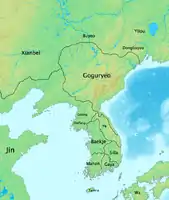 Korea in 300 AD
Korea in 300 AD Korea in 315 AD
Korea in 315 AD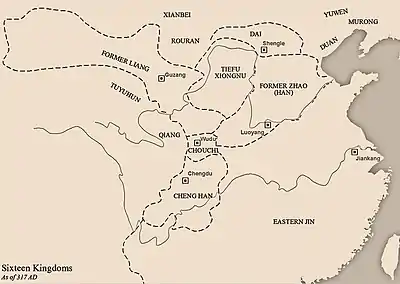 317 AD
317 AD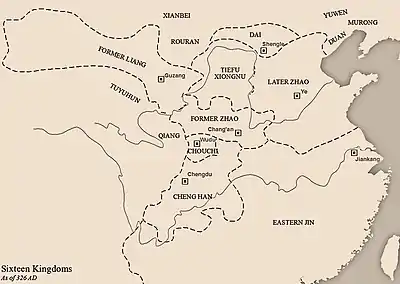 326 AD
326 AD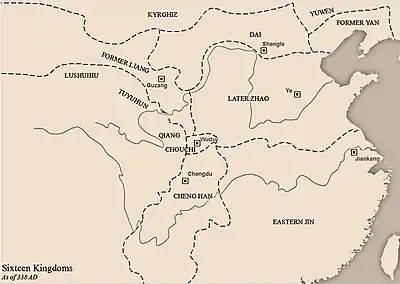 338 AD
338 AD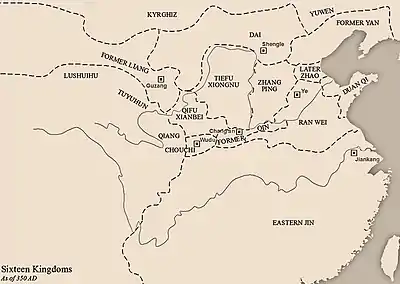 350 AD
350 AD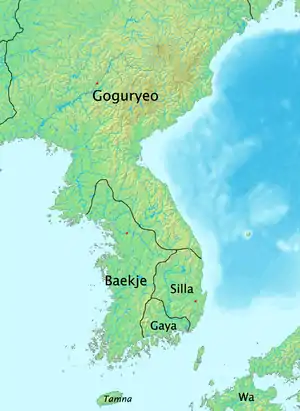 Korea in 375 AD
Korea in 375 AD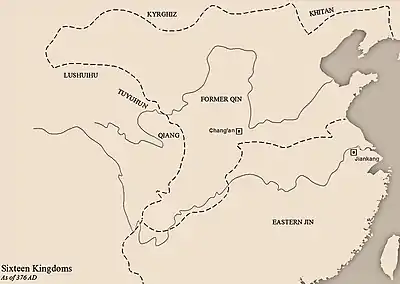 376 AD
376 AD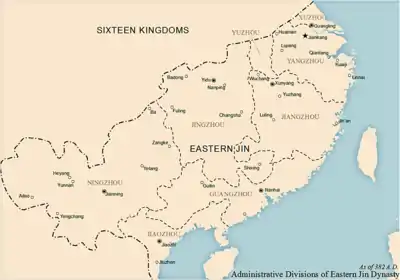 Eastern Jin, 382
Eastern Jin, 382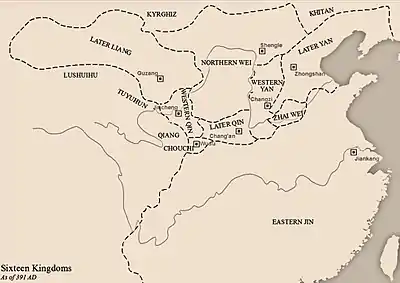 391 AD
391 AD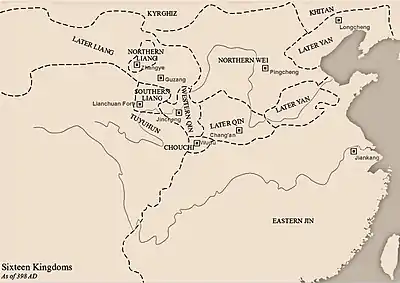 398 AD
398 AD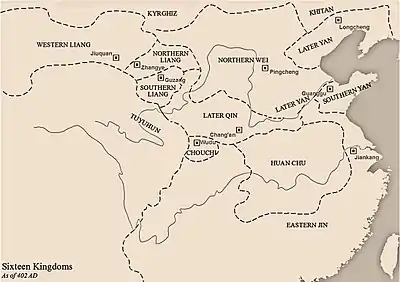 402 AD
402 AD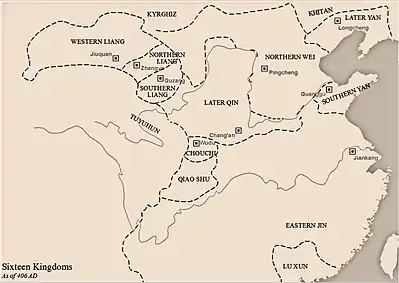 406 AD
406 AD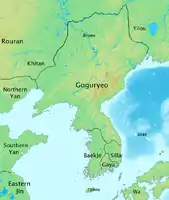 Korea in 410 AD
Korea in 410 AD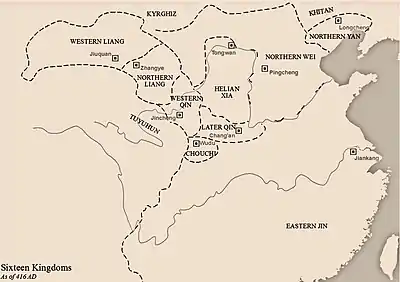 416 AD
416 AD 423 AD
423 AD 436 AD
436 AD
References
- Xiong 2009, p. xc.
- Xiong 2009, p. xci.
- Xiong 2009, p. 414.
- Xiong 2009, p. 400.
- Xiong 2009, p. xcii.
- Xiong 2009, p. xciii.
- Shin 2014, p. 30.
- Xiong 2009, p. xciv.
- Dien, Albert. "THE STIRRUP AND ITS EFFECT ON CHINESE MILITARY HISTORY"
- "The invention and influences of stirrup" Archived December 3, 2008, at the Wayback Machine
- Xiong 2009, p. 119.
- Xiong 2009, p. xcv.
- Xiong 2009, p. 135.
- Xiong 2009, p. xcvi.
- Twitchett 2008, p. 418.
- Xiong 2009, p. xcvii.
- Xiong 2009, p. 547.
- Xiong 2009, p. 123.
- Xiong 2009, p. xcviii.
- Xiong 2009, p. xcvii}i.
- Xiong 2009, p. xcix.
- Xiong 2009, p. 273.
Bibliography
- Crespigny, Rafe (2007), A Biographical Dictionary of Later Han to the Three Kingdoms (23-220 AD), Brill
- Shin, Michael D. (2014), Korean History in Maps, Cambridge University Press
- Xiong, Victor Cunrui (2009), Historical Dictionary of Medieval China, United States of America: Scarecrow Press, Inc., ISBN 0810860538
This article is issued from Wikipedia. The text is licensed under Creative Commons - Attribution - Sharealike. Additional terms may apply for the media files.
